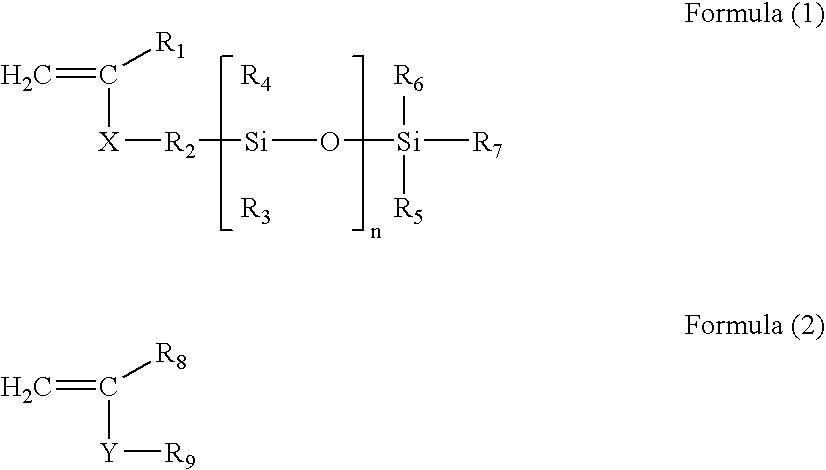Ink-jet recording pigment ink
a technology of pigment ink and recording pigment, which is applied in the field ofinkjet recording pigment ink, can solve the problems of poor weatherability and water resistance of printed materials, difficult to keep a good dispersion state of pigments, and no stable ejection performance is achievable, and achieves superior dispersion stability and high ejection stability
- Summary
- Abstract
- Description
- Claims
- Application Information
AI Technical Summary
Benefits of technology
Problems solved by technology
Method used
Image
Examples
example 1
[0056]Synthesis of Copolymer P1
[0057]Using materials shown below, polymerization reaction was carried out in the following way and under the following conditions. FM0725 (abbreviated as FM25; number average molecular weight: about 10,000; X represents an ester group, R1 represents a methyl group, R2 represents a propylene group, R3 to R6 represent a methyl group, R7 represents a hydrocarbon group in the Formula (1)), available from Chisso Corporation, was used as the silicone type macromer (abbreviated as SiM). Benzyl acrylate (abbreviated as BzA) was used as the vinyl monomer having a hydrocarbon group having 1 to 8 carbon atoms. Methacrylic acid (abbreviated as MAA) was used as the monomer having an anionic functional group. Then, in percentages by mass shown in Table 1, these materials were charged into a flask having a stirrer, a thermometer and a nitrogen feed pipe, to carry out polymerization reaction under the following conditions. That is, using 4 parts of azobisisobutylonit...
example 2
[0066]An example of a pigment ink making use of a silicone type macromer having a number average molecular weight of 6,000 or less is described in this Example.
[0067]Synthesis of Copolymer P2
[0068]Using the following materials formulated as shown in Table 2, polymerization reaction was carried out in the same way and under the same conditions as those in Synthesis of Copolymer P1 to obtain Copolymer P2 as shown in Table 2. FM0721 (abbreviated as FM21; number average molecular weight: about 5,000; X represents an ester group, R1 represents a methyl group, R2 represents a propylene group, R3 to R6 represent a methyl group, R7 represents a hydrocarbon group in the Formula (1)), available from Chisso Corporation, was used as the silicone type macromer (abbreviated as SiM). N,N-dimethyl acrylamide (abbreviated as MMAm) was used as the vinyl monomer having a hydrocarbon group having 1 to 8 carbon atoms. Maleic acid (abbreviated as Mal) was used as the monomer having an anionic functional ...
example 3
[0071]An example of a pigment ink making use of acrylic acid as the monomer having an anionic functional group is described in this Example.
[0072]Synthesis of Copolymer P3
[0073]Using the following materials formulated as shown in Table 3, polymerization reaction was carried out in the same way and under the same conditions as those in Synthesis of Copolymer P1 to obtain Copolymer P3 as shown in Table 3. FM0721 (abbreviated as FM21; number average molecular weight: about 5,000; X represents an ester group, R1 represents a methyl group, R2 represents a propylene group, R3 to R6 represent a methyl group, R7 represents a hydrocarbon group in the Formula (1)), available from Chisso Corporation, was used as the silicone type macromer (abbreviated as SiM). N,N-dimethyl acrylamide (abbreviated as MMAm) was used as the vinyl monomer having a hydrocarbon group having 1 to 8 carbon atoms. Acrylic acid (abbreviated as AA) was used as the monomer having an anionic functional group.
TABLE 3Materia...
PUM
| Property | Measurement | Unit |
|---|---|---|
| mass ratio | aaaaa | aaaaa |
| acid value | aaaaa | aaaaa |
| specific surface area | aaaaa | aaaaa |
Abstract
Description
Claims
Application Information
 Login to View More
Login to View More - R&D
- Intellectual Property
- Life Sciences
- Materials
- Tech Scout
- Unparalleled Data Quality
- Higher Quality Content
- 60% Fewer Hallucinations
Browse by: Latest US Patents, China's latest patents, Technical Efficacy Thesaurus, Application Domain, Technology Topic, Popular Technical Reports.
© 2025 PatSnap. All rights reserved.Legal|Privacy policy|Modern Slavery Act Transparency Statement|Sitemap|About US| Contact US: help@patsnap.com



